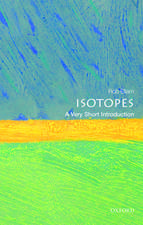Modern Aspects of Electrochemistry No. 6
Autor J. O'M. Bockris, B. E. Conwayen Limba Engleză Paperback – 25 noi 2012
Preț: 390.08 lei
Nou
Puncte Express: 585
Preț estimativ în valută:
74.64€ • 77.94$ • 61.64£
74.64€ • 77.94$ • 61.64£
Carte tipărită la comandă
Livrare economică 15-29 aprilie
Preluare comenzi: 021 569.72.76
Specificații
ISBN-13: 9781468430028
ISBN-10: 1468430025
Pagini: 400
Ilustrații: XIII, 381 p. 38 illus.
Dimensiuni: 140 x 216 x 21 mm
Greutate: 0.46 kg
Ediția:1971
Editura: Springer Us
Colecția Springer
Locul publicării:New York, NY, United States
ISBN-10: 1468430025
Pagini: 400
Ilustrații: XIII, 381 p. 38 illus.
Dimensiuni: 140 x 216 x 21 mm
Greutate: 0.46 kg
Ediția:1971
Editura: Springer Us
Colecția Springer
Locul publicării:New York, NY, United States
Public țintă
ResearchCuprins
1 Computed Thermodynamic Properties and Distribution Functions for Simple Models of Ionic Solutions.- I. Introduction.- II. Theoretical Background.- III. Some Results from Statistical Mechanics.- IV. Approximation Techniques.- V. MacMillan-Mayer Theory.- VI. Thermodynamics.- VII. Results Which Are Independent of the Model.- VIII. Properties of the Primitive Model.- IX. Some Other Models with Discontinuous Potentials.- X. Models with Continuous Potential Functions.- XI. Model Calculations in Some Related Areas.- XII. Supplement.- Acknowledgment.- References.- 2 Surface Potential at Liquid Interfaces.- I. Definitions.- II. Experimental Methods for Measuring Surface Potentials at Liquid Interfaces.- III. Surface Potential of Aqueous Solutions of Inorganic Electrolytes.- IV. Ionized Monolayers.- V. Incompletely and Un-ionized Monolayers.- Notation.- References.- 3 Transport Phenomena in Electrochemical Kinetics.- I. Introduction.- II. Flows Controlled by Motion of the Working Electrode.- III. Convective Diffusion at Electrodes with Flowing Solutions.- IV. Electrodes under Free Convection.- V. Applications to Electrochemical Kinetics.- VI. Conclusion.- References.- 4 The Mechanism of Charge Transfer from Metal Electrodes to Ions in Solution.- I. Introduction.- II. Gurney’s Quantum Mechanical Theory of Charge Transfer.- III. Developments of the Quantum Mechanical Theory.- IV. Absolute Reaction Rate Approach to Charge-Transfer Reactions.- V. Electrostatic Treatment of the Rate of Redox Reactions Hush’s Theory for Redox Reactions.- VI. Ion Tunneling.- VII. Concluding Remarks.- Acknowledgments.- Appendix I. The Transfer Coefficient.- Appendix II. The Adiabatic Principle and Related Approximations.- References.- 5 Electrochemical Processes in Glow Discharge at theGas-Solution Interface.- I. Introduction.- II. History.- III. Experimental Technique.- IV. Physical Features of GDE.- V. Glow-Discharge Phenomena in Conventional Electrolysis.- VI. Chemical Results of Glow-Discharge Electrolysis.- VII. Mechanism of Glow-Discharge Electrolysis.- VIII. Glow-Discharge Electrolysis and Radiation Chemistry.- IX. Applications of Glow-Discharge Electrolysis.- References.








